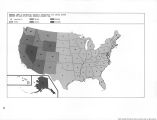| OCR Text |
Show direct supplier of most forms of outdoor recreation opportunity. Comprehensive statewide recreation plans have been developed by all 50 states, and some are undergoing third and fourth revision. Since 1965, states and local governments have added in the aggregate approximately 1.5 million acres of newly acquired land to their park systems and public recreation areas, bringing the total area in such systems to 36.5 million acres in the 50 states. Of the total national participation in outdoor recreation activity, based on data for the last year (1965) for which statistics are available, it is indicated that there were five times as many visits to areas administered by state and local governments as there were to areas administered by agencies of the Federal Government. This is readily understood since, as we have noted before, Federal public lands are seldom convenient to population centers while state and local facilities are. State and local entities throughout the Nation have incurred substantial levels of indebtedness through bond issues and borrowings to finance expanded park and recreation area programs. State financial assistance programs to local government have been developed in many states in support of these expanded program efforts, and state and local expenditures for outdoor recreation land acquisition and facilities development have exceeded Federal Land and Water Conservation Fund and Open Space grants by many times over. As indicated earlier in this report, there are a variety of types of public lands, ranging from desert and open prairies, with fragile soils, to heavily timbered and mountainous areas. Some of these lands have been set aside for specific forms of recreation, both passive and active, extensive and intensive. The bulk of the lands, however, have been managed under principles of multiple use, including outdoor recreation, and their suitability for such continued use is apparent. Among those lands that have been set aside for specific recreation uses are national parks, national seashores, wilderness areas, scenic trails, and scenic and wild rivers, all of which implement the Federal role of supplying land for areas of national significance. While national forests were not established primarily for recreation purposes, some of the best recreation areas-particularly for skiing-are found on the national forests, and many recent acquisitions of specific parcels of land by the Forest Service have been for recreation. The density of use varies widely among these different categories, and within categories. Wilderness areas, by definition, are intended to have limited use; some national parks and forests are subjected to bumper-to-bumper traffic and large numbers of people, while others have low rates of visitation. 198 The Commission's principal efforts have been devoted to an examination of the policies and practices related to the newly emerged intergovernmental division of responsibility for outdoor recreation. Generally, the public lands with which we are concerned fall into two categories in this respect. The public lands in national parks, monuments, seashores, scenic and wild rivers, and wilderness areas appear to be within the defined Federal role category suggested by ORRRC. These are the lands of truly national significance that have unique scenic or natural conditions, and for which only the Federal Government can, as a practical matter, be directly responsible for protection and management. These lands make up 33.3 million acres of the 755.3 million acres of Federal public lands with which we have been concerned generally. Our efforts with respect to these kinds of lands were directed at examining management policies and associated issues. The remaining 722 million acres of public lands are in the national forests, the wildlife refuge and game range system, and in unappropriated, unreserved areas administered by the Bureau of Land Management. Although specific recreation development policies for these lands are not well defined by statute, many administrative policies and on-going programs provide for their recreation development and use. It is this class of Federal public lands that the Commission has examined in the intergovernmental framework of national policy. We believe it is especially important to define carefully governmental roles and responsibilities in the area of outdoor recreation. Because people from the beginning of our Nation have had free access to land, they traditionally have not paid for that use when it is nonconsumptive. Therefore, private landowners have not generally made their lands available for public outdoor recreation purposes, and government has continued to act as the major supplier. The roles of each level of government should be explicit if duplication of effort is to be avoided and widespread public benefits are to be achieved. Inventory of Unique Areas Recommendation 78: An immediate effort should be undertaken to identify and protect those unique areas of national significance that exist on the public lands. There are areas in the National Forest System and on Bureau of Land Management lands that may qualify under existing standards for national parks, monuments, historic sites, wilderness areas, scenic and wild rivers, and national trails. They have not all |







































































































































































































































































































































































